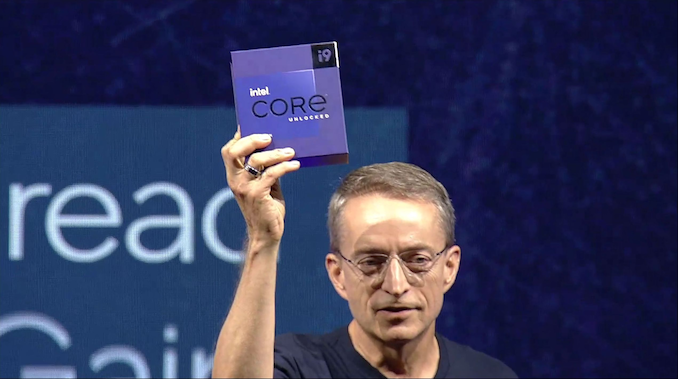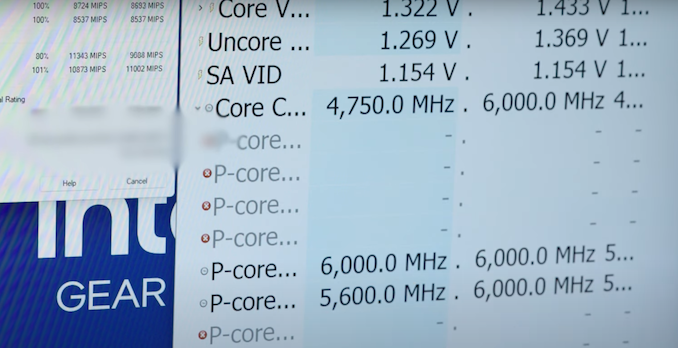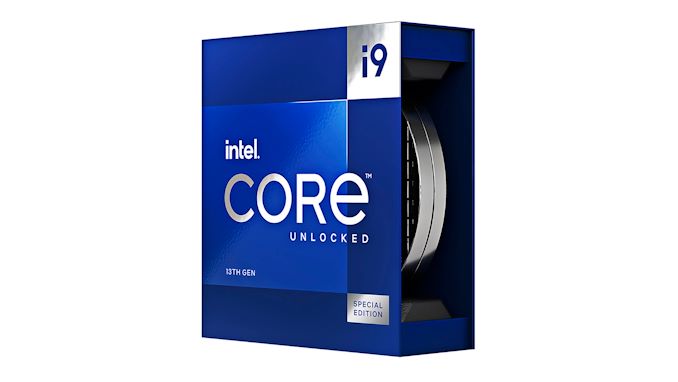Intel Unveils Core i9-13900KS: Raptor Lake Spreads Its Wings to 6.0 GHz
by Gavin Bonshor on January 12, 2023 9:00 AM EST
Initially teased by Intel CEO Pat Gelsinger during their Innovation 2022 opening keynote, Intel has unveiled its highly anticipated 6 GHz out-of-the-box processor, the Core i9-13900KS. The Core i9-13900KS is a special, highly clocked bin of the regular i9-13900K, offering the same 24-core (8P+16E) hybrid architecture, but with an impressive P-core maximum turbo clockspeed of up to 6 GHz.
Based on Intel's existing Raptor Lake-S desktop silicon, Intel claims that the Core i9-13900KS is the first desktop processor to reach 6 GHz out of the box without overclocking. With normal chips hitting up to 5.8GHz, the i9-13900KS is an even more extreme bin of that silicon, with Intel identifying chips that can run even harder to make it to 6 GHz. The trade-off for this extra burst of performance is that the power consumption of the chip is even higher than Intel's usual high-end desktop parts, with an official TDP of 150 Watts, and an "extreme" power profile that goes as high as 320 Watts under load.
Meanwhile, unlike most Intel CPU launches, the company is wasting no time on bringing their new special edition chip to market: the $699 CPU is available immediately.
Intel Core i9-13900KS: 6 GHz P-Core Turbo For $699
The Core i9-13900KS has been a long-awaited entrant to Intel's Raptor Lake-S for desktop family, with previous hints from Intel during their Innovation 2022 keynote that a 6 GHz out-of-the-box processor was on the horizon for this generation. As Intel likes to proclaim, the company considers the Core i9-13900KS to be a significant milestone for desktop PCs, thanks to its 6 GHz out-of-the-box P-Core turbo frequency. This makes it one of the fastest desktop x86 processors ever released, at least from the perspective of users who won't need to overclock anything to attain these ridiculous core frequencies.
This screenshot is taken directly from Intel's Core i9-13900KS promotional video
From Intel's sneak peek video on YouTube which was published on January 10th, the Core i9-13900KS looks to have reached 6 GHz on two of the eight performance (P) cores, with a clock speed of up to 5.6 GHz on the remaining six cores, which is very impressive, even for the already-capable Raptor Lake silicon. Intel hit 5 GHz on a shipping consumer CPU just a bit under three and a half years ago with the Core i9-9900KS, so this latest push to 6 GHz has come relatively quickly compared to the overall relaxed pace the x86 CPU frequencies have been moving at over the last decade or so.
Like its predecessor KS parts, the i9-13900KS is a special bin of Intel's existing silicon. Judging from end-user reports of overclocking the normal Core i9-13900K, we're left with the impression that very few of those chips could hit 6 GHz with ambient air cooling. So the i9-13900KS appears to be a very thin bin, though unlike the i9-12900KS launch, we haven't heard any official statistics from Intel this time around.
Of course, with even higher clockspeeds pushing the chip even farther away from the sweet spot on the voltage-frequency curve, the power consumption of this special edition chip has also gone up. The base TDP (as defined by Intel) is now 150 Watts, up from 125 W for the regular i9-13900K.
More interesting are the PL1 and PL2 power limits. For their latest chief chip, Intel has actually created two official power profiles, which is something they've never done before. The "base" profile sees both PL1 and PL2 set at 253 Watts; this is the same PL2 (turbo limit) as the i9-13900K, but PL1, the long-term expected steady state power consumption of a processor, his been boosted significantly from 125 W to the same 253 W value. PL1 is normally synonymous with a chip's official TDP, so I'm not sure the 150 W figure has much relevance here.
And for system builders that truly want to throw energy efficiency into the wind in favor of peak performance, the new "Extreme" power delivery profile further raises both PL1 and PL2 to 320 W, which correlates to an ICCMax current of 400 Amperes. While it (hopefully) shouldn't be necessary for the i9-13900KS to hit 6 GHz on its handful of favored cores, the extra power should come in handy for helping the remaining CPU cores also hold high clockspeeds, especially under heavy multi-threaded workloads.
Intel at this point hasn't specified how the multiple profiles will work (despite chips going on sale today), but between motherboard settings and Intel's XTU utility, one or both will undoubtedly have access. Otherwise, since the new extreme power profile is an official profile, Intel has confirmed that their standard warranty covers this higher powered mode.
Intel's current Intel 13th Gen Core i9 Series stack stands as follows (as of 01/12/23):
| Intel 13th Gen Core i9 Series: Raptor Lake-S (As of 01/12) | ||||||||||
| AnandTech | Cores P+E/T |
P-Core Base |
P-Core Turbo |
E-Core Base |
E-Core Turbo |
L3 Cache (MB) |
IGP | Base W |
Turbo W |
Price ($) |
| i9-13900KS | 8+16/32 | 3200 | 6000 | 2400 | 4300 | 36 | 770 | 150 | 253/320 | $699 |
| i9-13900K | 8+16/32 | 3000 | 5800 | 2200 | 4300 | 36 | 770 | 125 | 253 | $589 |
| i9-13900KF | 8+16/32 | 3300 | 5800 | 2200 | 4300 | 36 | - | 125 | 253 | $564 |
| i9-13900 | 8+16/32 | 2000 | 5600 | 1500 | 4200 | 36 | 770 | 65 | 219 | $549 |
| i9-13900F | 8+16/32 | 2000 | 5600 | 1500 | 4200 | 36 | - | 65 | 219 | $524 |
| i9-13900T | 8+16/32 | 1100 | 5300 | 800 | 3900 | 36 | 770 | 35 | 106 | $549 |
Comparing the Core i9-13900KS special edition processor directly to the regular Core i9-13900K, almost every clockspeed value has been cranked up to some degree. Thanks to the higher TDP, the official base clockspeeds for both the P and E cores are 200MHz higher, bringing them to 3.2 GHz and 2.4 GHz respectively. Meanwhile the highest turbo boost clockspeed on the P cores is now 6 GHz.
Like the basic i9-13900K, it's important to note that this is not an all-core turbo value – that is, not all 8 P cores will hit 6 GHz. As with the 5.8 GHz peak clockspeed on that chip, this is achieved by layering Intel's Thermal Velocity Boost (TVB) technology on top of their Turbo Boost Max 3.0 technology. Which to simplify things, means that the clockspeed is only guaranteed to be available on the chip's favored core pair, and even then only when the processor is running cool enough that there's enough thermal headroom to punch up the final 200MHz to 6 GHz.
Otherwise, the normal all-core turbo limit for the remaining P cores is 5.4 GHz, which means they can top out at 5.6 GHz when TVB is available. Meanwhile the E cores get no such love, and their turbo limit remains at 4.3 GHz, the same as on the regular i9-13900K.
Rounding out the package, the Core i9-13900KS offers the same 36 MB of L3 cache as Intel's other top-tier Raptor Lake desktop chips. And this is a graphics-enabled SKU, so Intel's UHD 770 integrated graphics are available.
Intel hasn't clarified how many Core i9-13900KS parts will be available during the lifecycle of Raptor Lake-S. As we've seen with previous iterations of its KS edition SKUs, there are typically a limited number of processors produced. Though as the high price tag also means that Intel moves relatively few chips overall, this is primarily an opportunity for Intel to show off with one faster chip.
Intel Client Computing Group (CCG) Manager Marcus Kennedy stated that "The Core i9-13900KS continues our 13th Gen Intel Core desktop processor family excellence, showcasing the new performance heights made possible by our performance hybrid architecture". He also said, "Extreme gamers and enthusiasts can now push their everyday performance further than ever before with the first desktop processor in the PC industry to provide 6.0 GHz speeds at stock".
The Intel Core i9-13900KS is available to buy now at PC retailers, with an MSRP of $699. Officially, this is $40 cheaper than the previous Core i9-12900KS, which launched last year at $739. Otherwise, based on current street prices, initial listings have the chip at closer to $729, which is $130 more than the i9-13900K ($599).












100 Comments
View All Comments
Hulk - Thursday, January 12, 2023 - link
I have a 13900K and while this seems interesting on the surface I wonder if these parts differ from the normal 13900K in that they simply have two really great cores that can reach 6GHz or all of the cores are better than the best 13900K? If it's the former than it's pretty much useless because it is so rare that you have an application that only uses 1 or 2 cores and allows the ramp up to 5.8GHz (or 6 in this case). But that latter could mean that at lower frequencies this is a cooler, more efficient part vs. the 13900K. The extra $120 to get a really great binned part could be worth it in that case.Unfortunately we have no information at this point in time. The increase in TDP makes me think this is just a more "leaky" part that can hit higher clocks at the expense of efficiency. That would be a shame because this would be completely a PR scheme.
Pneumothorax - Thursday, January 12, 2023 - link
There is some serious silicon lottery with Raptor lake. I built a few alder lake systems and their voltages were pretty similar to each other. I've built 4 13600K's so far and one ran at around 1.2V max, another at 1.3, and a junk chip that needed 1.4V at stock settings. Difference of up to 10C on the same NHD15 cooler on the best to the worst chip.Samus - Thursday, January 12, 2023 - link
Pneumothorax, I've noticed this too! In fact I believe this is why many boards overvolt the K chips by default. For example, the MSI Z690-A and Asus Tuf Z690 both run non-K chips at stock relaxed voltage while K chips are +0.100 offset by default, without the offset even being configured. This obviously causes the chips to run hotter even at idle, and there have been no negative effects when I set the offset manually to - and voltage offset to 0.100I wonder if board makers are aware of the silicon lottery and are padding the stability of their platforms by providing more voltage. This kind of sucks for consumers who don't realize this because you will run higher temps and shorted boost\turbo without oversized cooling.
While I realize the TDP is different between non-K and K chips, the voltages are not, so there is no other logical reason. Peak power draw should be determined by amp's being pulled, not voltage. There is no reason for any of these chips to be running at 1.4v-1.45v stock when the non-K (and even previous 12th gen K) run at 1.2v stock.
Pneumothorax - Friday, January 13, 2023 - link
I thought it was motherboard/bios issue, but they were all eventually tested on the same motherboard and CMOS was reset between each CPU. They definitely have very different core VIDs due to silicon lottery.meacupla - Thursday, January 12, 2023 - link
Reading and watching reviews, the 13900KS runs into thermal issues while on a 240mm CLC.The results are that it is barely any better than the 13900K.
Samus - Friday, January 13, 2023 - link
CLCs are a joke. They don't have long-term thermal capacity because the radiator IS the reservoir. Any cheap $40 Thermalright or BeQuiet twin tower cooler will outperform even a 360mm radiator CLC without a reservoir because eventually the fans wont keep up with coolant thermal runaway (unless you have enormous airflow.)Heatpipes have all the benefits and none of the drawbacks of a CLC. The primary benefit that your air cooler will last decades while your CLC will last, if you are lucky, a few years before the cheap-ass non-replaceable pump abruptly fails.
MarcusMo - Friday, January 13, 2023 - link
I don’t get your aversion to CLCs. All cooling systems are for sustained loads eventually limited by its ability to dissipate heat into the environment, reservoir or no reservoir. And if your plan is to have a reasonably sized chassis, a CLC is arguably the most efficient way to move heat. Any air-based solution is going to require much better airflow through the chassis and likely a larger, clumsier chassis as a consequence.As for stability, I have a Corsair H100 thats been going pretty much 24/7 for the last ten years on an old 5960x. Also I have several NZXT rigs that have been running flawlessly for the last four years.
Judging by your comment you’re obviously an experienced builder, but I just want to share that your experience with CLCs is not representative of everyone.
sonny73n - Saturday, January 14, 2023 - link
H100 lasted 10 years? Yeah right. The best fan in the market wouldn't last that long, let alone the motor and liquid in a CLC.CLC is overrated and trouble prone. If any CPU needs more than a NH-D15 to cool properly, that CPU is inefficient. In other word - garbage.
Dolda2000 - Saturday, January 14, 2023 - link
>The best fan in the market wouldn't [10 years]I'm not sure what you're using, but I've got *plenty* of fans that I've been running 24/7 for over 10 years for sure, including all of the fans in the i5 2400 computer I'm typing this on. Sure, I've got fans that have died as well, but in my experience that's very much the exception rather than the norm.
Byte - Monday, January 16, 2023 - link
I have an IFX-14 with the og thermalright YT140 from 2009 that has been running 24/7 most of its life and has no indications of failing soon. I have nice filters for my lianli v2000 case and minor dust. I have it mounted vertically now with the fans pull/pushing up because the mounting kits only allows that config on AM4 after using it with a intel 920, intel 3700k and now ryzen 3800.